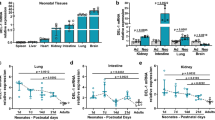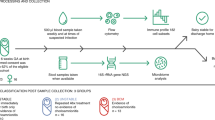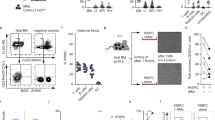Abstract
Newborn infants are highly susceptible to infection. This defect in host defence has generally been ascribed to the immaturity of neonatal immune cells; however, the degree of hyporesponsiveness is highly variable and depends on the stimulation conditions1,2,3,4,5,6,7. These discordant responses illustrate the need for a more unified explanation for why immunity is compromised in neonates. Here we show that physiologically enriched CD71+ erythroid cells in neonatal mice and human cord blood have distinctive immunosuppressive properties. The production of innate immune protective cytokines by adult cells is diminished after transfer to neonatal mice or after co-culture with neonatal splenocytes. Neonatal CD71+ cells express the enzyme arginase-2, and arginase activity is essential for the immunosuppressive properties of these cells because molecular inhibition of this enzyme or supplementation with l-arginine overrides immunosuppression. In addition, the ablation of CD71+ cells in neonatal mice, or the decline in number of these cells as postnatal development progresses parallels the loss of suppression, and restored resistance to the perinatal pathogens Listeria monocytogenes and Escherichia coli8,9. However, CD71+ cell-mediated susceptibility to infection is counterbalanced by CD71+ cell-mediated protection against aberrant immune cell activation in the intestine, where colonization with commensal microorganisms occurs swiftly after parturition10,11. Conversely, circumventing such colonization by using antimicrobials or gnotobiotic germ-free mice overrides these protective benefits. Thus, CD71+ cells quench the excessive inflammation induced by abrupt colonization with commensal microorganisms after parturition. This finding challenges the idea that the susceptibility of neonates to infection reflects immune-cell-intrinsic defects and instead highlights processes that are developmentally more essential and inadvertently mitigate innate immune protection. We anticipate that these results will spark renewed investigation into the need for immunosuppression in neonates, as well as improved strategies for augmenting host defence in this vulnerable population.
This is a preview of subscription content, access via your institution
Access options
Subscribe to this journal
Receive 51 print issues and online access
$199.00 per year
only $3.90 per issue
Buy this article
- Purchase on Springer Link
- Instant access to full article PDF
Prices may be subject to local taxes which are calculated during checkout




Similar content being viewed by others
References
Kollmann, T. R., Levy, O., Montgomery, R. R. & Goriely, S. Innate immune function by Toll-like receptors: distinct responses in newborns and the elderly. Immunity 37, 771–783 (2012)
PrabhuDas, M. et al. Challenges in infant immunity: implications for responses to infection and vaccines. Nature Immunol. 12, 189–194 (2011)
Zaghouani, H., Hoeman, C. M. & Adkins, B. Neonatal immunity: faulty T-helpers and the shortcomings of dendritic cells. Trends Immunol. 30, 585–591 (2009)
Adkins, B., Leclerc, C. & Marshall-Clarke, S. Neonatal adaptive immunity comes of age. Nature Rev. Immunol. 4, 553–564 (2004)
Kollmann, T. R. et al. Neonatal innate TLR-mediated responses are distinct from those of adults. J. Immunol. 183, 7150–7160 (2009)
Levy, O. et al. Selective impairment of TLR-mediated innate immunity in human newborns: neonatal blood plasma reduces monocyte TNF-α induction by bacterial lipopeptides, lipopolysaccharide, and imiquimod, but preserves the response to R-848. J. Immunol. 173, 4627–4634 (2004)
Siegrist, C. A. Neonatal and early life vaccinology. Vaccine 19, 3331–3346 (2001)
Gellin, B. G. & Broome, C. V. Listeriosis. J. Am. Med. Assoc. 261, 1313–1320 (1989)
Camacho-Gonzalez, A., Spearman, P. W. & Stoll, B. J. Neonatal infectious diseases: evaluation of neonatal sepsis. Pediatr. Clin. North Am. 60, 367–389 (2013)
Rotimi, V. O. & Duerden, B. I. The development of the bacterial flora in normal neonates. J. Med. Microbiol. 14, 51–62 (1981)
Ducluzeau, R. Implantation and development of the gut flora in the newborn animal. Ann. Rech. Vet. 14, 354–359 (1983)
Wirsing von König, C. H., Heymer, B., Finger, H., Emmerling, P. & Hof, H. Alteration of non-specific resistance to infection with Listeria monocytogenes. Infection 16 (suppl. 2). S112–S117 (1988)
Mold, J. E. & McCune, J. M. Immunological tolerance during fetal development: from mouse to man. Adv. Immunol. 115, 73–111 (2012)
Havell, E. A. Evidence that tumor necrosis factor has an important role in antibacterial resistance. J. Immunol. 143, 2894–2899 (1989)
Nakane, A., Minagawa, T. & Kato, K. Endogenous tumor necrosis factor (cachectin) is essential to host resistance against Listeria monocytogenes infection. Infect. Immun. 56, 2563–2569 (1988)
Pasparakis, M., Alexopoulou, L., Episkopou, V. & Kollias, G. Immune and inflammatory responses in TNF α-deficient mice: a critical requirement for TNF α in the formation of primary B cell follicles, follicular dendritic cell networks and germinal centers, and in the maturation of the humoral immune response. J. Exp. Med. 184, 1397–1411 (1996)
Bronte, V. & Zanovello, P. Regulation of immune responses by l-arginine metabolism. Nature Rev. Immunol. 5, 641–654 (2005)
Morris, S. M., Jr Arginine: master and commander in innate immune responses. Sci. Signal. 3, pe27 (2010)
Hermansen, M. C. Nucleated red blood cells in the fetus and newborn. Arch. Dis. Child. Fetal Neonatal Ed. 84, F211–F215 (2001)
Opiela, S. J., Levy, R. B. & Adkins, B. Murine neonates develop vigorous in vivo cytotoxic and TH1/TH2 responses upon exposure to low doses of NIMA-like alloantigens. Blood 112, 1530–1538 (2008)
Kalfa, T. A. et al. Rac1 and Rac2 GTPases are necessary for early erythropoietic expansion in the bone marrow but not in the spleen. Haematologica 95, 27–35 (2010)
Prins, H. A. et al. Arginase release from red blood cells: possible link in transfusion induced immune suppression? Shock 16, 113–115 (2001)
Millington, O. R., Di Lorenzo, C., Phillips, R. S., Garside, P. & Brewer, J. M. Suppression of adaptive immunity to heterologous antigens during Plasmodium infection through hemozoin-induced failure of dendritic cell function. J. Biol. 5, 5 (2006)
Muszynski, J. et al. Immunosuppressive effects of red blood cells on monocytes are related to both storage time and storage solution. Transfusion 52, 794–802 (2012)
Morera, D. & Mackenzie, S. A. Is there a direct role for erythrocytes in the immune response? Vet. Res. 42, 89 (2011)
Jackson, A., Nanton, M. R., O'Donnell, H., Akue, A. D. & McSorley, S. J. Innate immune activation during Salmonella infection initiates extramedullary erythropoiesis and splenomegaly. J. Immunol. 185, 6198–6204 (2010)
Akinosoglou, K. S., Solomou, E. E. & Gogos, C. A. Malaria: a haematological disease. Hematology 17, 106–114 (2012)
Kingsley, P. D. et al. Ontogeny of erythroid gene expression. Blood 121, e5–e13 (2013)
Maynard, C. L., Elson, C. O., Hatton, R. D. & Weaver, C. T. Reciprocal interactions of the intestinal microbiota and immune system. Nature 489, 231–241 (2012)
Abt, M. C. et al. Commensal bacteria calibrate the activation threshold of innate antiviral immunity. Immunity 37, 158–170 (2012)
Acknowledgements
We thank D. Haslam, M. Hostetter, L. Muglia, J. Whitsett and C. Wilson for discussions, J. Mortensen for help with anaerobic cultures, and K. Eaton, C. Schray and the University of Michigan Unit for Laboratory Animal Medicine for providing germ-free mice. We thank the Mount Auburn OB-GYN associates, OB-GYN residents, and the University and Christ Hospital labour and delivery nursing staff for collecting cord blood, the Cell Processing and Manipulation Core for obtaining peripheral blood from adult donors, and the CCHMC Translational Research Trials Office for providing the regulatory and administrative support for studies with human cells. This research was supported by NIAID (R01AI087830 and R01AI100934) (S.S.W.) and NHLBI (R01HL103745) (A.F.S.). S.S.W. holds an Investigator in the Pathogenesis of Infectious Disease award from the Burroughs Wellcome Fund.
Author information
Authors and Affiliations
Contributions
All authors performed or participated in the design of the experiments. S.E. and S.S.W. wrote the paper with editorial input from all authors.
Corresponding author
Ethics declarations
Competing interests
The authors declare no competing financial interests.
Extended data figures and tables
Extended Data Figure 1 Adoptively transferred splenocyte cells from adult mice are retained but do not become activated in L. monocytogenes (Lm)-infected neonatal mice.
a, The proportion of adult CD45.1+ donor cells compared with endogenous neonatal CD45.2+ cells among unfractionated splenocytes or various cell subsets 48 h after transfer to 5-day-old neonatal mice. b, The proportion of TNF-α-producing CD11c+ or B220+ cells among endogenous cells in adult or neonatal mice, or among transferred adult cells within neonates. c, Restored TNF-α production among neonatal cells after transfer to adult mice. The proportion of TNF-α-producing CD11b+ cells among transferred neonatal cells compared with endogenous adult cells. Forty-eight hours after infection, splenocytes were collected from infected or control mice, cultured in medium containing brefeldin A for 5 h and then subjected to cell surface and intracellular cytokine staining. Each point represents data from an individual mouse, and the data are representative of three independent experiments. Error bars, mean ± s.e.m.
Extended Data Figure 2 Diminished TNF-α and IL-6 production among human cord blood cells compared with adult peripheral blood mononuclear cells.
Representative plots and cumulative data showing TNF-α and IL-6 production by CD11b+ cells among adult peripheral blood mononuclear cells (PBMCs) or cord blood (CB) cells before and after stimulation with heat-killed (HK) L. monocytogenes (Lm). These results are representative of ten individual PBMCs or cord blood samples. Error bars, mean ± s.e.m.
Extended Data Figure 3 Neonatal splenocytes suppress the activation of adult cells in co-culture.
a, TNF-α production by adult CD11c+ and B220+ responder cells after stimulation with heat-killed (HK) L. monocytogenes (Lm), and co-culture with the indicated ratio of splenocytes from 6-day-old neonatal mice. b, Representative plots and composite data illustrating CD69 and CD25 expression by adult CD8+ responder cells after stimulation with anti-CD3 antibody, and co-culture with the indicated ratios of neonatal splenocytes. Each point represents data from an individual mouse, and the data are representative of three independent experiments. Error bars, mean ± s.e.m.
Extended Data Figure 4 Arginase inhibition overrides the immunosuppressive properties of neonatal cells.
TNF-α production by adult CD11b+ responder cells after stimulation with heat-killed (HK) L. monocytogenes (Lm) alone (black), or co-culture with neonatal splenocytes at a 1:1 ratio (blue), or additional supplementation (red) with arginase inhibitors (nor-NOHA or l-NOHA) (top), or 4-aminobenzoic acid hydrazide (a myeloperoxidase inhibitor), 4′-hydroxy-3′-methoxyacetophenone (an NADPH oxidase inhibitor), sodium diethyldithiocarbamate trihydrate (a superoxide dismutase inhibitor), SB-431542 hydrate (a TGF-β receptor inhibitor), anti-TGF-β antibody (clone 1D11), Sn(iv) protoporphyrin IX dichloride (a haem oxidation inhibitor), acetylcysteine (a reactive oxygen species (ROS) scavenger), 1-methyl-d-tryptophan and 1-methyl-l-tryptophan (IDO inhibitors), and an anti-IL-10 receptor antibody (clone 1B1.3A) (bottom). Each point represents data from an individual mouse, and the data are representative of two independent experiments. Error bars, mean ± s.e.m.
Extended Data Figure 5 Human cord blood compared with adult peripheral blood mononuclear cells is enriched with CD71+CD235A+ erythroid cells, and the depletion of these erythroid cells unleashes the activation of the remaining neonatal immune cells.
a, The proportion of CD71+CD235A+ cells among human adult PBMCs and cord blood. b, The proportion of CD71+CD235A+ cells among unfractionated and CD71+ cell-depleted cord blood (top), and the proportion of IL-6-producing cells among CD11b+ cells or the proportion of CD69+ cells among CD8+ cells in ten individual unfractionated and CD71+ cell-depleted cord blood specimens. The fold increase in CD71+ cell-depleted populations compared with unfractionated controls is shown above each pair of bars. Error bars, mean ± s.e.m.
Extended Data Figure 6 CD71+ cell depletion invigorates neonatal immune cell activation.
TNF-α-producing CD11c+ or B220+ cells after stimulation with heat-killed (HK) L. monocytogenes (Lm), or CD69 expression by CD8+ T cells after stimulation with anti-CD3 antibody among unfractionated or CD71+ cell-depleted splenocytes from 6-day-old neonatal mice. Each point represents data from an individual mouse, and the data are representative of three independent experiments. Error bars, mean ± s.e.m.
Extended Data Figure 7 Infection-induced cell activation is enhanced in the neonatal lymph node, where immunosuppressive CD71+ erythroid cell numbers are diminished.
a, The proportion of CD71+TER119+ cells among splenocytes and inguinal lymph node cells in 6-day-old neonatal mice. b, Representative plots and composite data comparing TNF-α production by CD11b+ cells and CD69 expression by CD8+ cells 48 h after L. monocytogenes (Lm) infection (red line histogram) or in no infection controls (black line histogram) in neonatal mice. Each point represents data from an individual mouse, and the data are representative of three independent experiments. Error bars, mean ± s.e.m.
Extended Data Figure 8 CD71+ cell depletion restores neonatal resistance to E. coli infection.
a, Recoverable bacteria 48 h after infection with the indicated E. coli doses in 6-day-old (neonatal) or 8-week-old (adult) mice. b, Recoverable bacteria 48 h after E. coli infection (200 CFU) of anti-CD71-antibody-treated neonatal mice compared with isotype-control-antibody-treated neonatal mice. Anti-CD71 antibody or isotype control antibody (150 μg) was administered on days 5 and 6 after birth, corresponding to 1 day before infection and the day of infection. Each point represents data from an individual mouse, and the data are representative of three independent experiments. Error bars, mean ± s.e.m.
Extended Data Figure 9 Phlebotomy-induced adult CD71+ erythroid cells have a similar subset distribution to neonatal cells but do not cause susceptibility to infection.
a, The proportion of CD71+TER119+ splenocytes in adult control or phlebotomized (bled) mice 5 days after the initiation of daily phlebotomy for 3 consecutive days. b, The distribution of TER119+ erythroid cells based on CD71 expression and size (FSC, forward scatter) among splenocytes from 6-day-old (neonatal) or phlebotomized 8-week-old (adult) mice. c, The number of recoverable bacteria after L. monocytogenes (Lm) infection (1,000 CFU). Each point represents data from an individual mouse, and the data are representative of three independent experiments. Error bars, mean ± s.e.m.
Extended Data Figure 10 CD71+ erythroid cells selectively restrict immune cell activation in the intestine.
a, Relative CD40, CD80 and CD86 expression by CD11b+ or CD11c+ cells recovered from the indicated tissues of 8-day-old (neonatal) mice treated with 150 μg anti-CD71 antibody (red histograms gated on CD11b+ cells) or 150 μg isotype control antibody (blue histograms gated on CD11b+ cells) on days 5 and 6. The mean fluorescence intensity for each parameter in the cells from CD71+ cell-depleted mice was normalized to the levels in isotype-control-antibody-treated mice. b, CD40, CD80 and CD86 expression for the neonatal mice described in a after receiving antibiotic supplementation. c, CD40, CD80 and CD86 expression for the neonatal mice described in a after maintenance under gnotobiotic germ-free conditions. Each point represents data from an individual mouse, and the data are representative of three independent experiments. Error bars, mean ± s.e.m.
Rights and permissions
About this article
Cite this article
Elahi, S., Ertelt, J., Kinder, J. et al. Immunosuppressive CD71+ erythroid cells compromise neonatal host defence against infection. Nature 504, 158–162 (2013). https://doi.org/10.1038/nature12675
Received:
Accepted:
Published:
Issue Date:
DOI: https://doi.org/10.1038/nature12675
This article is cited by
-
Harnessing large language models (LLMs) for candidate gene prioritization and selection
Journal of Translational Medicine (2023)
-
Short-term intensive fasting enhances the immune function of red blood cells in humans
Immunity & Ageing (2023)
-
Tumor-associated myeloid cells in cancer immunotherapy
Journal of Hematology & Oncology (2023)
-
Early-life interactions between the microbiota and immune system: impact on immune system development and atopic disease
Nature Reviews Immunology (2023)
-
Immunologische Konsequenzen bei frühgeborenen Kindern
Gynäkologische Endokrinologie (2023)
Comments
By submitting a comment you agree to abide by our Terms and Community Guidelines. If you find something abusive or that does not comply with our terms or guidelines please flag it as inappropriate.



